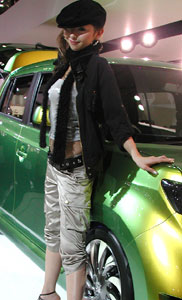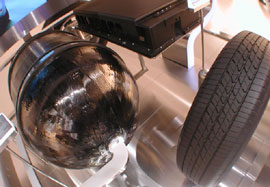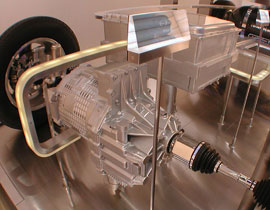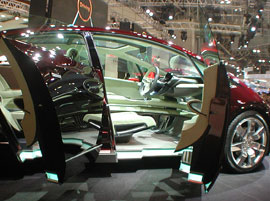Fuel Cell Vehicles at the Tokyo Motor Show
In his memoirs, Henry Ford wrote of the Captain: "His one slight adjustment to my original assembly circle was the key to our success." The rest, as they say, is history.
 This week the Captain's profiling another pioneering concept: fuel cell vehicles. He has the pedal to the metal as he test drives a few at the 2005 Tokyo Motor Show
This week the Captain's profiling another pioneering concept: fuel cell vehicles. He has the pedal to the metal as he test drives a few at the 2005 Tokyo Motor Show
In a white smock and clutching a stack of notes, Nobutaka Takahashi stares down at the internal skeleton model of Nissan's X-Trail fuel cell vehicle (FCV) on display at the 2005 Tokyo Motor Show.
Since the industrial revolution spawned only the internal combustion engine and not a provision for a $70-a-barrel rate for oil, alternative fuel vehicles are the talk of this year's show. For Takahashi, a member of Nissan's research and development team, this is his baby.
"It is difficult to design and lay out the parts so that everything fits into the car," he says of his eco-SUV, shaking his head.
Take the hydrogen tank. Finding an appropriate location for a container the size of a large beach ball can be cumbersome.
Such are the challenges that lie ahead for the pioneering work of the designers of the vehicles that will perhaps represent the future direction of the automotive industry.
 For FCVs, centrally located fuel cell stacks host chemical reactions between stored hydrogen and oxygen from the air to create the electricity that drives the motor. Water and heat are the only by-products, making FCVs eco-friendly modes of transportation.
For FCVs, centrally located fuel cell stacks host chemical reactions between stored hydrogen and oxygen from the air to create the electricity that drives the motor. Water and heat are the only by-products, making FCVs eco-friendly modes of transportation.
Aside from a digital dash display reporting various technical information, the design of the X-Trail is similar to a standard SUV: five seats, four doors, and plenty of room for passengers. The major differences are in the operation.
Unlike its combustion cousins, turning over the ignition of the acqua blue X-Trail results in little noise. Motion of the wheels begins with a tap of the accelerator and the 85 kW electric motor receiving A/C power from a fuel stack.
For the newest X-Trail, top speeds of 145 km/h and a cruising range of over 500 km are possible. An automatic air conditioning system refrigerated by carbon dioxide keeps passengers comfortable.
Ever since Nissan first started experimenting with fuel cells back in 1996, advancements have been steady.
 The latest fuel cell stack has been improved vastly over prevoius versions of the X-Trail with its components being integrated and size being shrunk by 60% but with its power output remaining the same.
The latest fuel cell stack has been improved vastly over prevoius versions of the X-Trail with its components being integrated and size being shrunk by 60% but with its power output remaining the same.
A change in the winding pattern of the carbon fibers of the high-pressure hydrogen storage tank has allowed for a doubling of its pressure and a 30% boost in its hydrogen storage capacity. This has increased the vehicle's driving range.
Energy is stored in a lithium-ion battery pack, something Takahashi says sets the X-Trail apart from its competitors. "This is our selling point," he boasts.
The battery is a laminated lithium-ion cell that represents a substantial improvement over the prevoius cylindrical shape found in past versions of the X-Trail. As a result, the weight and volume is 50% less. A thinner cell construction has also improved cooling efficiency.
 Not to be outdone in this new market, Honda unveiled its concept fuel cell car, the maroon FCX. With two hydrogen tanks above its rear axel, this sleek sedan features the option of supplying residences with heat and electricity. Also entering the fray is Suzuki with its Ionis concept minicar, an FCV with its stack set beneath the cabin floor to allow for a large interior space.
Not to be outdone in this new market, Honda unveiled its concept fuel cell car, the maroon FCX. With two hydrogen tanks above its rear axel, this sleek sedan features the option of supplying residences with heat and electricity. Also entering the fray is Suzuki with its Ionis concept minicar, an FCV with its stack set beneath the cabin floor to allow for a large interior space.
In the past few years, Nissan has been leasing its eco-baby to oil refiner Cosmo Oil Co., the city of Yokohama, and the prefecture of Kanagawa at a rate of 1 million yen a month.
Even with oil prices having doubled over the past five years, FCVs will still have to wait their turn. Since costs for development of the X-Trail is at a prohibitively high 120 million yen each and public awareness of the technology relatively small, Takahashi acknowledges that it will be some time before his project becomes widespread.
"The market is very small right now because there is little demand," Takahashi says. "We are not needed yet."
Note: The introductory photo has very little to do with fuel cell vehicles. For a video of a few cars, go to TokyoDV.

